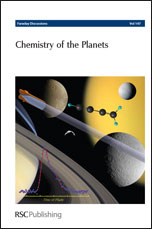The temperature dependence of the branching ratios for H atom production from the reactions of the first excited state of methylene (a1A11CH2) with acetylene and ethene have been measured at ∼1 Torr total pressure and temperatures of 195, 250 and 298 K by monitoring the production of H atoms using laser induced fluorescence, comparing the signal to that observed from a calibration reaction. For the reaction with acetylene the yield of H increases from 0.28 (195 K) to 0.53 (250 K) to 0.88 at 298 K. The H atom yield from the reaction of 1CH2 with ethene shows similar behaviour, the yields being 0.35 (195 K), 0.51 (250 K) and 0.71 (298 K). The co-products, propargyl (C3H3) and allyl (C3H5) are formed from the dissociation of chemically activated C3H4 and C3H6 intermediates respectively, and are important species in the formation of higher hydrocarbons, including benzene, in the atmospheres of the outer planets and Titan. H atom production is in competition with electronic relaxation to form ground state methylene (X3B1, 3CH2) and collisional stabilization to form C3H4 and C3H6. Master equation calculations have been carried out to demonstrate that for the reaction of 1CH2 with acetylene, collisional stabilization is insignificant under experimental conditions and hence the balance of reaction is due to electronic relaxation. Non-adiabatic transition state theory has been applied to the reaction of 1CH2 with acetylene. The calculations show reasonable agreement with experiment, generally being within the combined errors, and reproduce the negative temperature dependence for electronic relaxation. The implications of the temperature dependence of the absolute rate coefficients for 1CH2 reactions with inert gases, hydrogen, acetylene and ethene and of the branching ratios between chemical reaction and electronic relaxation are discussed.
You have access to this article
 Please wait while we load your content...
Something went wrong. Try again?
Please wait while we load your content...
Something went wrong. Try again?

 Please wait while we load your content...
Please wait while we load your content...